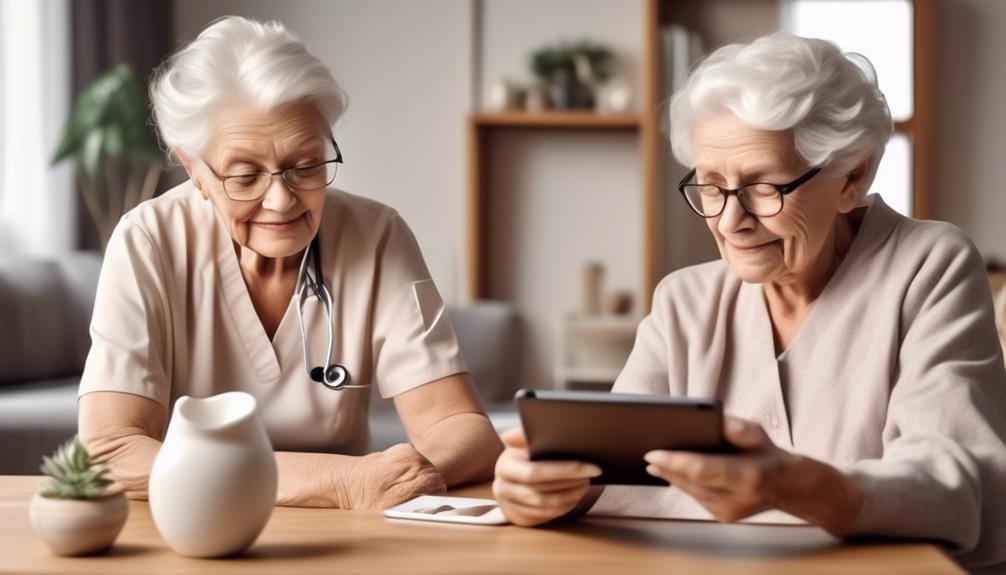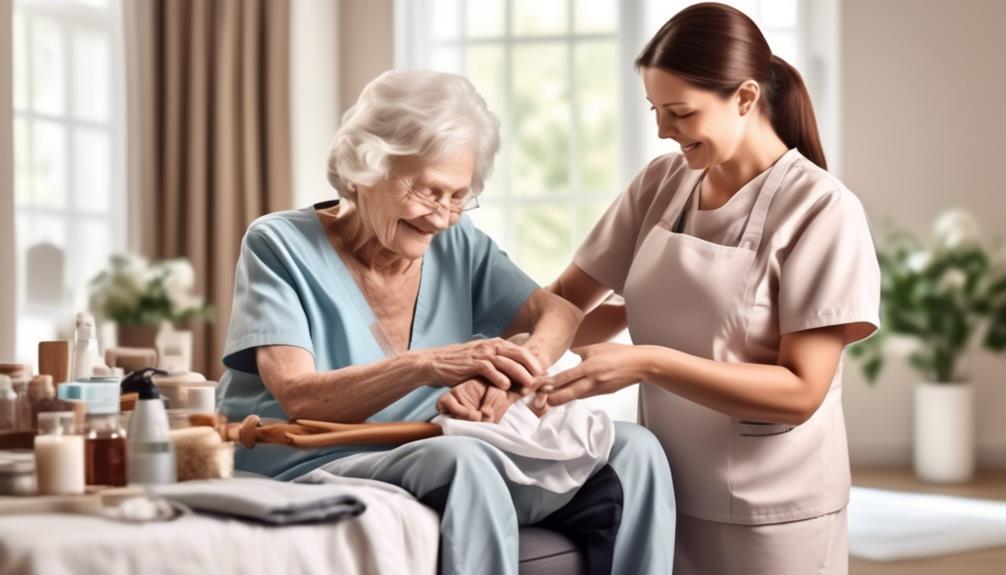Exploring telehealth services for elderly individuals looking to age in their own homes can offer them increased independence and convenient access to medical treatment. With the help of technological advancements, seniors can now bridge the gap of physical distance and effortlessly obtain top-notch healthcare services through online platforms with a simple click of a button.
But what does this mean for the future of aging in place? The possibilities are vast, the benefits promising, and the impact profound. Join us as we explore the realm of telehealth for seniors and unlock the potential it holds for aging gracefully in the comfort of one's own home.
Key Takeaways
- Convenient access to healthcare services from home
- Real-time monitoring for proactive health management
- Simplified medication adherence and remote consultations
- Enhanced quality of life through virtual care technologies
Benefits of Tele-health for Seniors
With tele-health services, seniors experience enhanced access to healthcare while maintaining the comfort and safety of their own homes. For older adults, especially those looking to age in place, telehealth offers a lifeline to essential healthcare services. Through virtual visits, seniors can swiftly connect with healthcare providers, reducing the need for travel and potential exposure to illnesses. The continuous health monitoring provided by telehealth platforms ensures that seniors receive timely care and intervention when needed, supporting their desire to remain independent in their homes.
Furthermore, telehealth appointments typically don't come with extra costs for seniors, making healthcare more affordable and convenient. This accessibility not only benefits older patients but also alleviates the burden on caregivers who play a crucial role in seniors' health and well-being. By embracing telehealth, seniors and their caregivers can enjoy the peace of mind that comes with improved healthcare outcomes and enhanced quality of life.
Tele-health Platforms for Aging in Place

Telehealth platforms for aging in place offer a comprehensive range of services that cater to the unique healthcare needs of older adults, ensuring continuous access to quality medical care from the comfort of their own homes. These platforms enable older adults to connect with remote healthcare providers, bridging the gap for those who may have difficulty accessing traditional healthcare settings.
By utilizing wearable devices, telehealth platforms monitor vital signs and health conditions in real-time, enhancing health monitoring capabilities and allowing for timely interventions. mHealth applications integrated into these platforms not only promote healthy behaviors but also provide mental health services and facilitate social connections, addressing the holistic needs of aging individuals.
Moreover, medical alarm systems within telehealth platforms ensure quick access to emergency services, especially crucial for situations like fall detection. Additionally, technology for medication reminders, such as electronic pill bottles and ingestible sensors, supports medication adherence among older adults aging in place, promoting their overall well-being and independence.
How Tele-health Works for Seniors
When considering how tele-health works for seniors, it's important to understand the seamless integration of remote healthcare services through innovative telecommunication technology. Telehealth offers a lifeline to seniors by providing virtual visits, continuous monitoring, medication management, and fostering social connections. Here's how tele-health is benefiting seniors:
- Virtual Visits: Seniors can easily connect with healthcare providers from the comfort of their homes, eliminating the need for travel.
- Continuous Monitoring: Remote monitoring devices and wearable technologies enable real-time tracking of health parameters, ensuring timely interventions.
- Medication Management: Telehealth simplifies medication adherence through reminders and virtual consultations, promoting better health outcomes.
- Social Connections: Seniors can combat isolation and loneliness by engaging in virtual social activities and support groups, enhancing overall well-being.
- Accessibility: Telehealth services cater to older adults with mobility limitations or those residing in rural areas, ensuring equitable access to quality healthcare.
Telehealth is revolutionizing senior care, offering convenience, personalized attention, and improved quality of life.
Getting Started With Tele-Health

Navigating the realm of tele-health for seniors can initially feel overwhelming, but taking the first steps towards understanding and utilizing these remote healthcare services is crucial for enhancing your well-being as you age in place. To help you get started, here are some key points to consider:
| Getting Started With Tele-Health | ||
|---|---|---|
| 1. Research Telehealth Options | 2. Set Up Technology | 3. Choose a Provider |
| Look into different telehealth services available for older adults. | Ensure you have the necessary technology for virtual visits. | Select a healthcare provider that offers remote access. |
| Understand how telehealth can address healthcare shortages in your area. | Familiarize yourself with how to navigate virtual appointments. | Consider the provider's experience with providing quality care remotely. |
| Take note of the benefits of reduced travel and exposure to illnesses through telehealth. | Seek assistance in setting up and troubleshooting any technological issues. | Discuss your preferences and health needs with the provider for personalized care. |
Embarking on your telehealth journey can lead to improved access to healthcare services and a better quality of life as you age in place.
Enhancing Senior Care With Tele-Health
Embarking on the journey of enhancing senior care with tele-health allows us to embrace the possibilities of improved access to healthcare services and a better quality of life for our aging loved ones. Utilizing telehealth technologies can significantly enhance the overall care provided to older patients:
- Improved Healthcare Access: Telehealth services connect older adults with healthcare providers remotely, ensuring they can access care conveniently.
- Remote Monitoring: Remote patient monitoring through telehealth enables continuous health monitoring for seniors, aiding in the early detection and management of health issues.
- Aging in Place Support: Telehealth platforms support aging in place by providing seniors with access to healthcare services from the comfort of their homes.
- Chronic Condition Management: Telehealth services help older adults manage chronic conditions effectively, ensuring they receive timely care and support.
- Enhanced Senior Care: Virtual care technologies, including telehealth, allow older adults to receive medication reminders, access mental health support, and overall improve their quality of life.
Frequently Asked Questions
What Are the Challenges of Telehealth for Elderly People?
We understand the challenges elderly individuals face with telehealth. Limited digital literacy, hearing or vision impairments, physical limitations, cognitive impairments, and lack of necessary technology or internet access can all hinder their engagement.
It's important to provide patient, empathetic support, and guidance to help them navigate these obstacles. By addressing these challenges with understanding and patience, we can help make telehealth services more accessible and beneficial for elderly individuals.
How Do You Teach Patients About Telehealth?
When teaching patients about telehealth, we explain its benefits and how appointments can happen through video calls, phone calls, or email. We highlight the convenience of remote access and emphasize preparing patients by reviewing technology basics.
It's crucial to guide them on accessing and navigating telehealth services effectively. Our goal is to ensure a smooth setup for patients to receive healthcare services conveniently and efficiently.
What Are the Barriers to Telemedicine Video Visits for Older Adults in Independent Living Facilities?
Barriers to telemedicine video visits for older adults in independent living facilities include:
- Limited tech adoption
- Lack of high-speed internet
- Unfamiliarity with platforms
- Privacy concerns
- Cognitive/physical limitations
These challenges hinder engagement in virtual healthcare. To overcome barriers, tailored support, user-friendly tools, and privacy assurances are crucial. Empathy and patience are key in addressing these obstacles and ensuring older adults can access the care they need through telemedicine.
What Are the Four Areas Where Telemedicine Telehealth Are Used Currently?
Telemedicine and telehealth have become essential tools in providing remote healthcare services. They are used for a variety of purposes, including remote consultations, chronic condition management, medication oversight, and mental health services.
These technologies offer convenient access to medical advice, continuous care for seniors, medication management, and emotional support. They play a vital role in remote health monitoring by tracking vital signs and symptoms in real-time for proactive interventions.
Such services enhance the safety, effectiveness, and personalized care for older adults in their homes.
Conclusion
In conclusion, telehealth for aging in place offers seniors splendid support and seamless access to healthcare services. With the wonders of technology, older adults can stay connected, monitored, and cared for from the comfort of their own homes.
By embracing telehealth, seniors can enjoy enhanced well-being, improved independence, and efficient emergency assistance. Let's leap into the future of senior care with telehealth!








